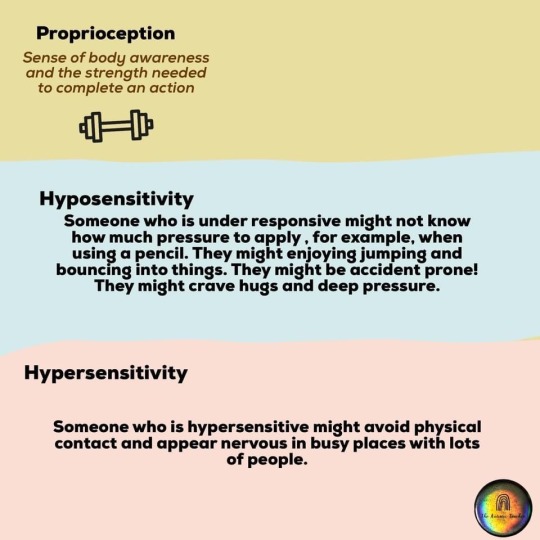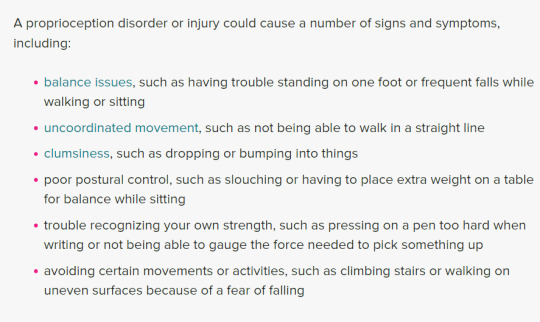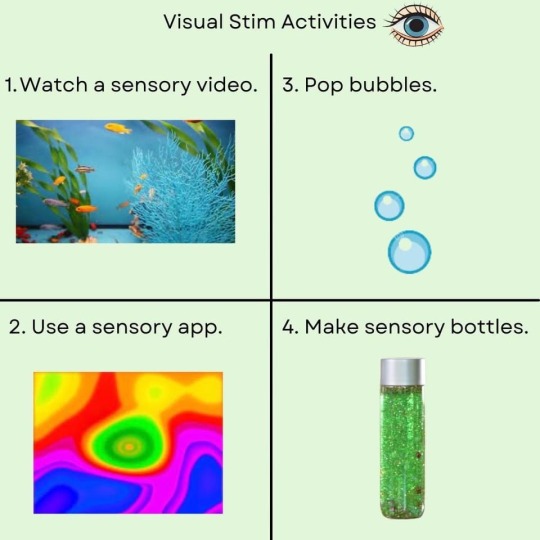#proprioception
Text


Discomfort.
#autism#actually autistic#actually autism#neurodiversity#neurodivergent#neurodivergence#comics#webcomic#original comic#autism community#actuallyautistic#actually neurodivergent#proprioception#interoception#asd#autistic#autistic artist
5K notes
·
View notes
Text
shout out to people with spatial awareness issues. wishing you a "didn't bump into any table corners or walls" day today!
#dogpost#when i get my own place all my stuff is gonna have no corners. round tables ftw#autism#spatial awareness#spatial reasoning#dyspraxia#developmental coordination disorder#ehlers danlos syndrome#proprioception#balance disorder#edit: why did this go off so intensely!!#nearly 1.5k notes in less than 10 days. i have like 300 followers MAYBE if that#damn people really out here bemoaning their shin bruises huh#edit 2: i just checked i have 150 followers. where did these notes come from
12K notes
·
View notes
Text
The 8 Senses









The Autistic Teacher
#autism#actually autistic#the 8 senses#Olfactory#tactile#auditory#Gustatory#visual#vestibular#Proprioception#Interoception#autism and the senses#sensory processing#sensory processing disorder#neurodivergence#neurodiversity#actually neurodivergent#feel free to share/reblog#The Autistic Teacher (Facebook)
350 notes
·
View notes
Text
I am going to be very suddenly taking up dancing (<- will be in very Dancy musical). I have a few questions for autistic dancers specifically (tho anyone else who struggles with proprioception, e.g. dyspraxics, is welcome to answer)
did dance help your overall proprioception at all? balance coordination etc. this is a question for PEOPLE WHOS PROPRIOCEPTION NATURALLY SUCKS I know if ur like Normal ur stuff will get better but I wanna know how it is with natural deficit as someone who has a chance of falling down every time i stand up
was learning to dance. hell. am i about to just put myself through hell with little benefit or improvement.
do yall have any like..... basic balance/coordinaiton tips or knowledge so I can maybe not look Incredibly stupid
67 notes
·
View notes
Note
Do you know what the difference between dyspraxia & having bad proprioception is? I know I have poor proprioception but according to everything I’ve read proprioception mostly affects being able to tell where your body is in relation to other things. I definitely can’t tell how much space I take up, but I also really struggle to do things like open packages, pick up small objects, tie my shoes, etc. and I’m starting to wonder if I have actual dyspraxia as well as bad proprioception.
hi 😊
i did some research and found out that there is a high chance of an autistic person having both proprioception problems and dyspraxia, so the chance of you having both (which wouldn't be surprising) is most definitely possible


as for the differences 👇


so, you managed to sum it up pretty well
essentially, proprioception problems mainly have to do with the whole body, while dyspraxia is more focused on individual movements
here are the links to the articles i used 👇, i suggest reading them through if you haven't already :)
Proprioception: What It Is, Problems, Diagnosis, Treatment & More (healthline.com)
Dyspraxia: Symptoms, Causes, Diagnosis & Treatments (healthline.com)
#anybody with dyspraxia or proprioception problems please chime in#especially if you are autistic !#autism#autistic#actually autistic#asd#autism spectrum disorder#on the spectrum#dyspraxia#proprioception
47 notes
·
View notes
Text
I listened to classical music in my swing today! Brahms Clarinet Sonatas (No.1 and No. 2.), Saint-Saëns Clarinet Sonata in E-flat Major.
Classical music (particularly with clarinet) is so deeply important to me. I love Romantic composers especially. It has always been a way I can express emotions that I can't express in other ways. Words are not needed. Playing clarinet helped me survive.
And it is so regulating to me - especially to play, but also to listen. My body automatically moves with the music - I breathe when there is breaths or pauses, my hands twirl and flap in highly energetic parts, certain muscles clench according to where in my body I feel the music.
Swinging at the same time means I am completely in my element of music and movement and rhythm.
It is so regulating, in fact, that after the music finished and I stood up from my swing - I felt so much more balanced and grounded and tethered than I have in a long time. I walked better and more smoothly than I have in probably years!
My actual physical sense of balance and proprioception and vestibular sense, all became as steady and balanced as they ever can be.
It is amazing, this effect that music and movement has on me and my body and brain. I feel fantastic, so balanced!
#from the chaos of my mind#music#classical music#clarinet#brahms#saint saens#autism#autistic#sensory processing disorder#proprioception
18 notes
·
View notes
Text
babygirl I'm impaired in senses you've never heard of
339 notes
·
View notes
Text
Theory: Zooble hates being taken apart because when that happens their digital proprioceptors start screaming at their brain that “ThAt LeG IsN’t SuPpOsEd tO bE tHeRe” which makes them feel really uncomfortable.
#the amazing digital circus#tadc zooble#the amazing digital circus zooble#Zooble’s my favorite character#Zooble is underrated#character study#proprioception#tadc theory#it’s more of a hypothesis really
18 notes
·
View notes
Text

So this popped up on my watch this morning. You see as part of the Fitness program it will occasionally toss out little challenges. Go on a 20 min outdoor walk on Earth Day, that sort of thing. They break up the daily grind of working out and for the most part I enjoy them. This one is for International Dance Day.
Nope.
Not gonna do it. Not even going to try. It’s not that I have anything against dancing mind you. It’s that I can’t. Never have been able to. I don’t even really understand the theory. But maybe that’s the problem. Maybe there is no theory. Regardless, I can’t, People have tried to teach me but I don’t know what to do. I’m too uncoordinated, and clumsy. There are too many variables and I can’t manage them all. People will say things like “You just have to feel the music”. I don’t even know what that means.
Understand that this is not a new thing. I have never been able to dance. I skipped all the school dances when I was a teenager, yes, even the Prom, I had no wish to get dressed up and take someone to an event that I knew I would be terrible at. Going dancing never even crossed my mind any more than taking up parkour or skydiving. Some years later my partner and I were at a wedding reception and they insisted that I dance with them. One time around the room, a series of squashed toes, collisions with other dancers, and at least once tripping over my own feet we arrived back at our table. They sat me down and have never asked again.
I’m not kidding when I say that I cannot dance.
So today is International Dance Day and I’m going to mark it by not doing a bloody thing.
2 notes
·
View notes
Text

Research has determined that fascia tissues have 6x to 8x more proprioceptive sensory nerve endings than red muscle (Schleip 2017).
This makes the fascia system arguably the body’s largest sensory organ.
The spindle receptors in muscles are primarily located in areas where force transfer happens at the muscle-tendon unit (MTU). When it comes to sensing where we are in space and time, the fascia system provides our most important interface.
(Hira Sutra)
6 notes
·
View notes
Text
Sensory Activities for Each Sense








Neurodivergent_lou
#neurodivergence#neurodiversity#actually neurodivergent#sensory activities#stimming#vestibular#visual#auditory#tactile#smell#taste#proprioception#feel free to reblog/share#Neurodivergent_lou (Facebook)
300 notes
·
View notes
Text


NEODYIMUM X ARSENIC the boys are fightiiiiing
#blood#jang animates#afotd#achluophobia: fear of the dark#oc tag: edison powers#oc tag: Auer Neodymius Merc'her#2023 art#proprioception#who knew one way to get back into the swing of things (animating) was to animate gratuitous violence and gore!#jangart#jang anims
7 notes
·
View notes
Text
Your brain is actively aware of the locations of your teeth, cheeks, tongue, and lips and their positions relative to one another and will (most of the time) work to keep you from biting yourself while also coordinating everything for you to talk, eat, etc.
I just think proprioception is cool, okay?
#it's like#you're covered with motion-capture balls#but they're on the inside#and your brain has a live feed of a pre-res stick-figure#bumbling around#but it works#proprioception#teeth
4 notes
·
View notes
Text
Ep. 9 - Let’s go on a little walk
Hello my fellow souls,
welcome back to Danbi’s Room, your weekly dose of safe space. Go grab a cup of something warm and get yourself cosy.
I hope you had a nice and stress-free week, and that the upcoming shifting of seasons can give you a sense of refreshment.
These days I was thinking about the endless and the limitless. Well, I was trying to wrap my head around them. You know, it’s basically impossible for the human brain to actually grasp and picture the concept of something that has no end, whether it’s time or space or both. And it’s true, if we stop at wanting to visualize it we encounter a lot of difficulty. But what if we descend into the recesses of our soul and we try to feel it?
To explain this further I need to digress a bit into what the 6th sense is. We are used to think about our senses as 5. Nevertheless, for a while now, the people of science have defined the 6th sense: Proprioception. Essentially it’s our body parts communicating with our brain to tell it where each of them is at any given time. It’s our body knowing where we stand.
By the way, I’d recommend you to look it up in more depth, it’s a very interesting and eye-opening scientific research.
But what has this to do with being able to feel endlessness? Well, I believe we could individuate a 7th sense. A sort of proprioception of the soul, of our eternal energy as particles of the universe. I mean, it’s undeniable that what we’re made of has always been here and it will always be. We are, in fact, eternal: we simply shape-shift and remix with others. We carry within us our ancestors and our successors. The stars of the beginning and the stars of the ending and all of what will happen afterwards.
We can’t think of eternity and endlessness as already experienced events (as we do with all of our mental references) because we are experiencing them right now. Since they know no bounds we are continuously and perpetually experiencing them. Endlessness is our never-ending present. From that perspective we might also say time doesn’t exist. We can just call it flow if you will. Everything flows, and that is a very good thing. Deep down there’s something in us knowing we are everywhere all around the universe. That’s why our power is also limitless. It’s true, though, that realising this can be scary. It’s definitely a lot. It means welcoming all of this spatial awareness and if, for a moment, we forget we’re welcoming it together with our companions from all over the cosmos, it could even crush our spirit. Always remember the pack. Always remember that you don’t have to carry everything alone on your shoulders. We can hold our hands and take a stroll on the shores of this immense ocean until each of us is ready to freely swim in it. Until each mind has one direction and we’re completely and everlastingly connected. Or, even better, until we accept and welcome this collective awareness into our personal consciousness.
Does this feel like too much?
Don’t forget micro and macro are one the mirror of each other. If thinking about all of the collective feels too overwhelming just close your eyes, and, instead of promenading from one star to the other, we can just take a little walk and see the world inside of us. We can just be there and know this will never end for eternity.
Today’s song recommendation is our Chris’s latest release: Eternity by Bang Chan. The very sound of a soft breeze gently moving your hair while the last beams of light of a late summer sunset softly caress your cheeks before letting you be embraced by the blue hour.
I hope you enjoyed this episode and that you have a beautiful week ahead of you!
I’ll see you in the next one, big hug!
With love, yours,
Danbi
#community#cozycore#cozy#danbisroom#safe space#aesthetic#blog#chans room#bang chan#stray kids#eternity#skz record#song of the day#neverending#proprioception#big hug#danbi#connected#flow
2 notes
·
View notes
Text
Cervical instability at the core of fibromyalgia?
I just want to pick up the thread of cervical instability and its relationship with chronic pain again, as written about just the other day in the context of covid (having found numerous suggestions that covid can aggravate or even instigate cervical instability). In particular, I want to look at how this one, often unnoticed, structural issue might very well be lurking there right at the very…

View On WordPress
#articles#cervical instability#cervical instability and fibromyalgia#chronic health conditions potential cause#dysautonomia#ehlers danlos sydrome#fibromyalgia#Hypermobility#PoTS#proprioception#proprioceptive dysfunction#tension myositis syndrome (TMS)#text neck#vagus nerve#what causes fibromyalgia?
3 notes
·
View notes
Link
Abstract
Your brain keeps you alive and well by running a metabolic “budget” for your body. Our authors, who co-direct the Interdisciplinary Affective Science Laboratory at Northeastern University and Massachusetts General Hospital, explain how these budgetary activities, and the sensations they create inside your body, suggest surprising connections between brain, mind, body, and world.
Right now, as you read this text, it may seem like your eyes are simply detecting words out there in the world. But you’re not detecting—you’re constructing. In every moment, outside of your awareness, your brain constructs a model of the outside world, transforming light waves, pressure changes, and chemicals into sights, sounds, touches, smells, and tastes. Your brain continually anticipates what will happen next around you, checks its predictions against sense data streaming in from your eyes, ears, and other sensory surfaces of your body, updates the model as needed, and in doing so creates your experience of the world. This covert construction of your senses is called exteroception.
Your brain also models the events occurring inside your body. In much the same way that your brain sees sights, feels things that touch your skin, and hears sounds, it also produces your body’s inner sensations, such as a gurgling stomach, a tightness in your chest, and even the beating of your heart. Your brain also models other sensations from movements that you cannot feel, such as your liver cleaning your blood. The construction of all your inner sensations is called interoception and, like exteroception, it proceeds completely outside your awareness.
For a long time, scientists treated interoception and exteroception as completely separate domains of sensation, bounded by your skin. But recent research has revealed that the two might not be as separate as they seem, and their boundary is fuzzy. Perhaps more importantly, the science of interoception reveals some surprising insights about how your brain works and may be a key to better understanding health and illness.
Your Brain Runs a Budget for Your Body
You live in a complex body. With over 600 muscles in motion and dozens of internal organs, your body pumps 2,000 gallons of blood per day, balances dozens of hormones and other chemicals, regulates the energy of billions of neurons, digests food, excretes waste, and fights illness—all of it nonstop throughout your life. Your brain’s most important job is to coordinate and control the systems of your body as they burn and replenish energy efficiently. Your brain ensures that the right amounts of salt, glucose, water, and other vital resources are available where and when they’re needed, so you can walk, think, learn, innovate, and love. This constant budgeting of your body’s needs is called allostasis.
Allostasis is a predictive balancing act. Your brain moves your body through a massively complex world full of other brains-in-bodies, so it must constantly guess which of your cells need what resources… and guess well. If your heart rate is too fast or slow for the physical demands you face, or your lungs don’t process sufficient oxygen, or your cells become insensitive to the glucose that ultimately powers your muscles, you’re not likely to live long. So, your brain is engaged in the constant body-budgeting of allostasis, anticipating your body’s needs at every moment while deciding which efforts are worth the metabolic investment. Right now, for example, your brain is using some glucose and other metabolic resources to read these words. Learning and moving your body are some of your brain’s most costly operations, metabolically speaking.
Efficient energy regulation, therefore, is a major selection pressure for all living things. Animals live longer and suffer from fewer diseases when their tissues, organs, and systems receive the right nutrients just when they are needed. Such animals are more fit to reproduce. They can explore further for food and better protect themselves from predators, learning all the while and honing their models of the world. The more effectively and efficiently a brain can invest its energy, therefore, the greater the metabolic return.
Go to:
Sensing the World Around You
Reading this text depends on seeing, which is one form of exteroception. To perform this activity, your brain makes metabolic investments to model the world outside your body. It directs your eye muscles to contract and relax in a pattern that allows your eyes to sweep across a line of text—at each moment predicting what you will see next, based on past experience (see Figure 1). Your brain then directs your eyes to stop and fixate briefly to compare its predictions to the visual data arising from the page. It makes any necessary corrections and then directs the next volley of eye movements.
Vision, like other forms of exteroception, operates in the service of movement. Think about it: How do you know how far away to hold this page, so the article is legible? How do you even know where your limbs are in space? How do you manage not to bump into things when you walk, successfully guide your spoon to your mouth, or pick up a cup with the right amount of force? It’s all about sensation and its intimate ties to allostasis. Your brain sees, hears, feels physical contact, and constructs other sensations not because these activities are intrinsically fun or valuable, but because sensations are the means by which your brain controls your body’s many moving parts. Your movements give your brain the sense data to build its model of the world, and this model guides your actions, ultimately supporting allostasis so you survive, and even thrive, in the world around you.
Exteroception works mostly by prediction. Your brain issues motor commands, say, to move the muscles of your head, eyes, and other body parts (even before you’re aware) and simultaneously predicts the sensations likely to result from those movements. When the actual sense data arrives from the sensory surfaces in your eyes, skin, and other sense organs, your brain integrates the data to confirm or correct the predictions to refine or adjust the motor movements. In constructing your sensations, your brain estimates the state of the world in order to control and coordinate your body’s movements.
Go to:
Sensing the World Inside You
The muscles attached to your skeleton are not the only moving parts of your body. As you read this article, your brain is conducting a mostly silent symphony of movement inside your body, involving your organs, autonomic nervous system, endocrine system, and immune system. Your lungs continually expand and contract to take in oxygen and expel carbon dioxide as your heart beats to pulse blood throughout your body and brain. If what you’re reading seems interesting or unexpected, your heart rate and respiration may slow.
Many other things that you might not think of as movements are indeed movements of a sort. For example, the flow of your saliva to aid digestion; the surge of chemicals that create inflammation; and the gush of cortisol from your adrenal glands. (Cortisol has been called a stress hormone, but it is more correct to call it a metabolic hormone; it gets glucose into your bloodstream quickly when your brain predicts your body will need it.) Even conversations between the cells of your intestine and the bacteria that reside there are considered motor movements; this constant chatting aids digestion, and over time can even adjust the length of your intestine to regulate how quickly you digest!
Interoception, like exteroception, operates in the service of movement predictively. Here’s the gist: Your brain issues motor commands that adjust the insides of your body, and it simultaneously predicts the sensory consequences of those movements. At the same time, the sensory surfaces inside your body, including dozens of cells that monitor pressure changes, temperature, contractions, stretches, nutrients, gases, toxins, and various chemicals, send a steady stream of sensory signals back to your brain via electrical impulses in your spinal cord and swirling chemicals in your blood. Your brain integrates these sensory signals to confirm or correct the predictions and adjust its predicted movements, if necessary, thereby maintaining allostasis efficiently. In this way, your brain anticipates the needs of your body and proactively coordinates the internal movements that deliver glucose, water, salt, oxygen, and other resources to an infinite amount of cells just in time.
For example, think of the last time you were thirsty and drank a glass of water. Within seconds after draining the last drops, you probably felt less thirsty. This event might seem ordinary, but the water actually takes about 20 minutes to reach your bloodstream, so it can’t possibly quench your thirst in a few seconds. What relieved your thirst? Prediction. As your brain plans and executes the actions that allow you to swallow, it simultaneously anticipates the interoceptive consequences of gulping water, causing you to feel less thirsty long before your brain learns from the body about your increased hydration.
Go to:
New Insights and Deep Implications
There is still much to learn about the mechanisms of interoception and what they mean for health, illness, and basic mental functions. Exteroceptive senses such as vision are relatively better understood—perhaps because scientists are often guided by their experiences, and we don’t experience most interoceptive activity. Nevertheless, creative research by those who do study interoception has brought forth some intriguing insights. New ideas are transforming our most basic understanding of brains and bodies and challenging our most basic assumptions of how they work together to create the mind, control actions, and cause illness. We’ll share three such insights that blur three fundamental boundaries: what is inside versus outside the body, what is mental versus physical illness, and what distinguishes different mental phenomena.
MORE >>>
Interoception: The Secret Ingredient :: Lisa Feldman Barrett, Ph.D. and Karen S. Quigley, Ph.D.
35 notes
·
View notes